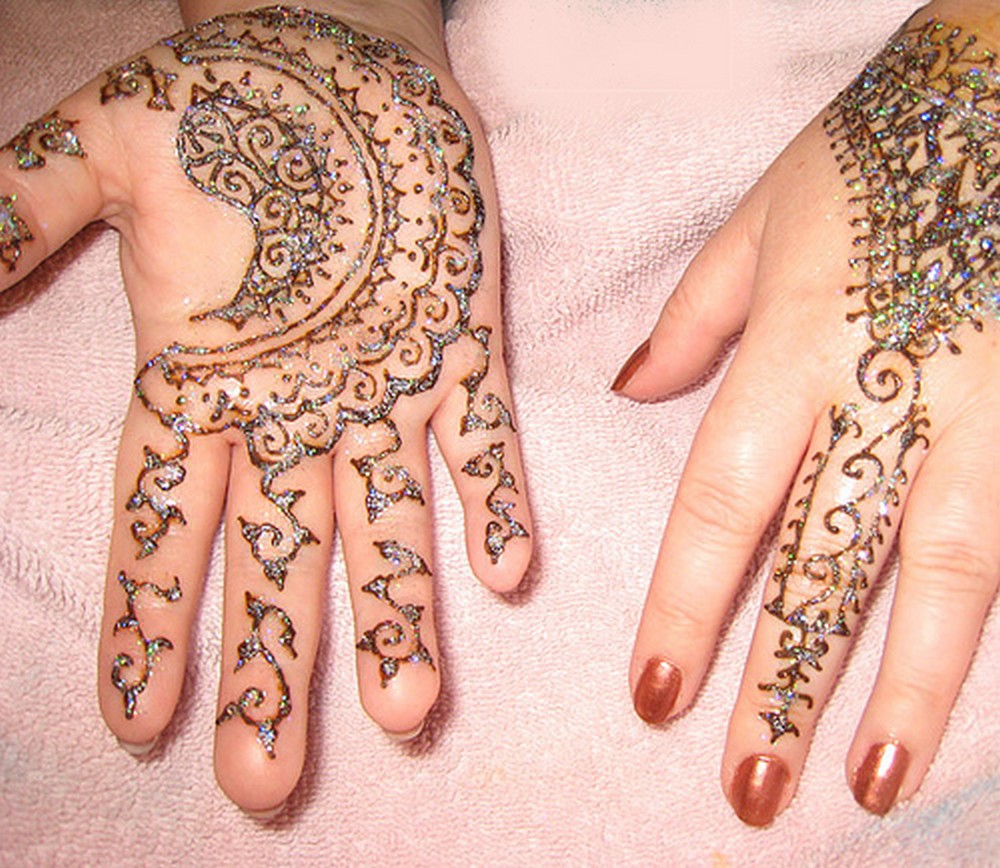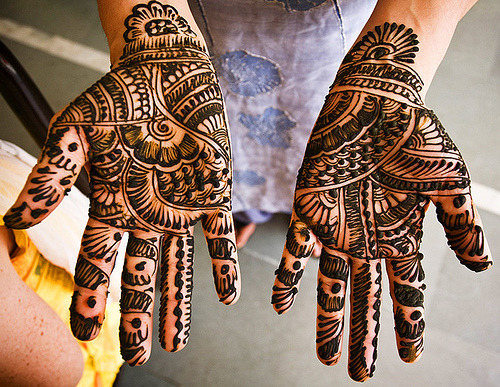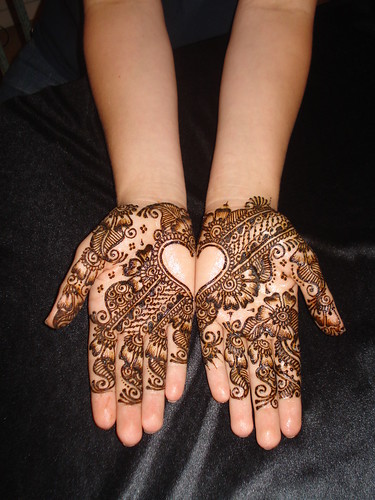Pics Of Bridal Mehndi Biography
source(google.com.pk)
Arab construction is very thick and soft, have fine lines between designs.Arabic Bridal henna mehndidesignsfillings can be called as a bold line.Indian brides love Arabic mehndi designsbecause they the name of theirhusband, a cord, shoulder, upper back and waist hidden, like arm.
It some of the names on the first night, to find all hidden bride momeitneun that is the duty of the husband.Arabic mehndi designsare very old-style;
we also know the history of art is very old. That is why itsdesignis based on current trends continue, a change in time and time of the history ofmehndi. Mehndi designsare always five of the population of the Earth about globe. A many now well known in changed names, asmehndi tattooand body want to have a tattoo mehndi tattoo, tattoos, a lot of nature only Brief and remove automatically after 10 -15, dependingon family released dirt after thetattoo.Arabic mehndi designsbelow have several facets.
A full hand design, either palm or back with the help of henna paste looks always trendy.
Henna Designs For Palm
While Arabic henna designs are usually large, floral patterns on the hands, Indian mehndi involves fine, thin lines for lacy, floral and paisley patterns covering entire hand and also forearms. Most traditional henna patterns are based on very simple shapes - circles, triangles and lines are the most basic. These shapes can be combined to create a very intricate pattern and a very beautiful henna design on palm.
The various mehendi designs meant for hands include flower arches, henna web, flower net, flowery trails, lucky lotus, leaves chains etc. While decorating an entire hand, one can start where it is most comfortable, depending on the design. Common starting points are the line where the fingers bend bordering the palm, the wrist, or the center of the palm. It is usually easiest to begin by covering the palm, and then doing the fingers.Henna Designs For Feet
Henna Designs For FeetHenna designs done on the feet, involves painting beautiful and elaborate patterns with a dye made from crushed leaves of the henna plant. The Middle Eastern style consisted mostly of floral patterns inspired by Arabic carvings, paintings and textiles. This casual style did not usually follow a specific pattern. The North American style accentuated the shape of the feet using geometric floral patterns. The Indian and Pakistani designs are made up of intricate, repetitive paisley patterns, lines and teardrops.
Some of the popular designs for feet include flowers, leafy tendrils, and abstract shapes. Applying henna designs on feet are a little more difficult, but can be created easily with a bit of concentration. Usually, the sides or bottoms of the feet, are decorated with blocks of color on the tips of toes.
Henna Designs For Body DecorationHenna artisans brings along its creative henna art that include all the latest trends that come in, to give a continues variety. From tiny roses on shoulders to full body motifs, tattoos have made their way into the mainstream life as a modern genre of artistic expression.
Intrigued by the creation of beautiful designs on the body, henna mehndi is being used by women worldwide as a mode of self-expression. The designs originate from the practices followed on these occasions and represent specific objects, dresses, floral designs, leaves, flowers and birds associated with the festival.
The word mehndi is derived from the Sanskrit word mendhikā.[1] The use of mehndi and turmeric is described in the earliest Hinduism's Vedic ritual books. Haldi (staining oneself with turmeric paste) as well as mehndi are Vedic customs, intended to be a symbolic representation of the outer and the inner sun. Vedic customs are centered around the idea of "awakening the inner light".
Mehandi, also known as henna is a temporary form of skin decoration in mainly India and Nepal. People in Pakistan, Bangladesh and the Maldives as well as by expatriate communities from those countries also use Mehandi. This tradition also spread to exist among some Arab Women particularly the Cooperation Council for the Arab States of the Gulf nationals.
Traditional Indian designs are of representations of the sun on the palm, which, in this context, is intended to represent the hands and feet.
Mehndi decorations became fashionable in the West in the late 1990s, where they are sometimes called henna tattoos. Henna is typically applied during special Hindu occasions like weddings and festivals like Karva Chauth, Diwali, Bhaidooj and Teej. Muslims festivals adopted subsequently during Eid-ul-Fitr and Eid-ul-Adha as well. In Hindu festivals, many women have Henna applied to their hands and feet. It is usually drawn on the palms and feet, where the design will be clearest because the skin on these surfaces naturally contains less of the pigment melanin. Henna was originally used as a form of decoration mainly for Hindu brides.
In the modern age, usually people buy ready=made Henna cones, which are ready to use and make painting easy. However, in rural areas in India, women grind fresh henna leaves on grinding stones with added oil, which though not as refined as professionally prepared henna cones, brings much darker colors.
The term henna tattoo is figurative, because true tattoos are permanent surgical insertions of pigments underneath the skin, as opposed to pigments resting on the surface as is the case with mehndi.










Arab construction is very thick and soft, have fine lines between designs.Arabic Bridal henna mehndidesignsfillings can be called as a bold line.Indian brides love Arabic mehndi designsbecause they the name of theirhusband, a cord, shoulder, upper back and waist hidden, like arm.
It some of the names on the first night, to find all hidden bride momeitneun that is the duty of the husband.Arabic mehndi designsare very old-style;
we also know the history of art is very old. That is why itsdesignis based on current trends continue, a change in time and time of the history ofmehndi. Mehndi designsare always five of the population of the Earth about globe. A many now well known in changed names, asmehndi tattooand body want to have a tattoo mehndi tattoo, tattoos, a lot of nature only Brief and remove automatically after 10 -15, dependingon family released dirt after thetattoo.Arabic mehndi designsbelow have several facets.
A full hand design, either palm or back with the help of henna paste looks always trendy.
Henna Designs For Palm
While Arabic henna designs are usually large, floral patterns on the hands, Indian mehndi involves fine, thin lines for lacy, floral and paisley patterns covering entire hand and also forearms. Most traditional henna patterns are based on very simple shapes - circles, triangles and lines are the most basic. These shapes can be combined to create a very intricate pattern and a very beautiful henna design on palm.
The various mehendi designs meant for hands include flower arches, henna web, flower net, flowery trails, lucky lotus, leaves chains etc. While decorating an entire hand, one can start where it is most comfortable, depending on the design. Common starting points are the line where the fingers bend bordering the palm, the wrist, or the center of the palm. It is usually easiest to begin by covering the palm, and then doing the fingers.Henna Designs For Feet
Henna Designs For FeetHenna designs done on the feet, involves painting beautiful and elaborate patterns with a dye made from crushed leaves of the henna plant. The Middle Eastern style consisted mostly of floral patterns inspired by Arabic carvings, paintings and textiles. This casual style did not usually follow a specific pattern. The North American style accentuated the shape of the feet using geometric floral patterns. The Indian and Pakistani designs are made up of intricate, repetitive paisley patterns, lines and teardrops.
Some of the popular designs for feet include flowers, leafy tendrils, and abstract shapes. Applying henna designs on feet are a little more difficult, but can be created easily with a bit of concentration. Usually, the sides or bottoms of the feet, are decorated with blocks of color on the tips of toes.
Henna Designs For Body DecorationHenna artisans brings along its creative henna art that include all the latest trends that come in, to give a continues variety. From tiny roses on shoulders to full body motifs, tattoos have made their way into the mainstream life as a modern genre of artistic expression.
Intrigued by the creation of beautiful designs on the body, henna mehndi is being used by women worldwide as a mode of self-expression. The designs originate from the practices followed on these occasions and represent specific objects, dresses, floral designs, leaves, flowers and birds associated with the festival.
The word mehndi is derived from the Sanskrit word mendhikā.[1] The use of mehndi and turmeric is described in the earliest Hinduism's Vedic ritual books. Haldi (staining oneself with turmeric paste) as well as mehndi are Vedic customs, intended to be a symbolic representation of the outer and the inner sun. Vedic customs are centered around the idea of "awakening the inner light".
Mehandi, also known as henna is a temporary form of skin decoration in mainly India and Nepal. People in Pakistan, Bangladesh and the Maldives as well as by expatriate communities from those countries also use Mehandi. This tradition also spread to exist among some Arab Women particularly the Cooperation Council for the Arab States of the Gulf nationals.
Traditional Indian designs are of representations of the sun on the palm, which, in this context, is intended to represent the hands and feet.
Mehndi decorations became fashionable in the West in the late 1990s, where they are sometimes called henna tattoos. Henna is typically applied during special Hindu occasions like weddings and festivals like Karva Chauth, Diwali, Bhaidooj and Teej. Muslims festivals adopted subsequently during Eid-ul-Fitr and Eid-ul-Adha as well. In Hindu festivals, many women have Henna applied to their hands and feet. It is usually drawn on the palms and feet, where the design will be clearest because the skin on these surfaces naturally contains less of the pigment melanin. Henna was originally used as a form of decoration mainly for Hindu brides.
In the modern age, usually people buy ready=made Henna cones, which are ready to use and make painting easy. However, in rural areas in India, women grind fresh henna leaves on grinding stones with added oil, which though not as refined as professionally prepared henna cones, brings much darker colors.
The term henna tattoo is figurative, because true tattoos are permanent surgical insertions of pigments underneath the skin, as opposed to pigments resting on the surface as is the case with mehndi.
Pics Of Bridal Mehndi

Pics Of Bridal Mehndi

Pics Of Bridal Mehndi

Pics Of Bridal Mehndi

Pics Of Bridal Mehndi

Pics Of Bridal Mehndi

Pics Of Bridal Mehndi

Pics Of Bridal Mehndi

Pics Of Bridal Mehndi

Pics Of Bridal Mehndi

No comments:
Post a Comment